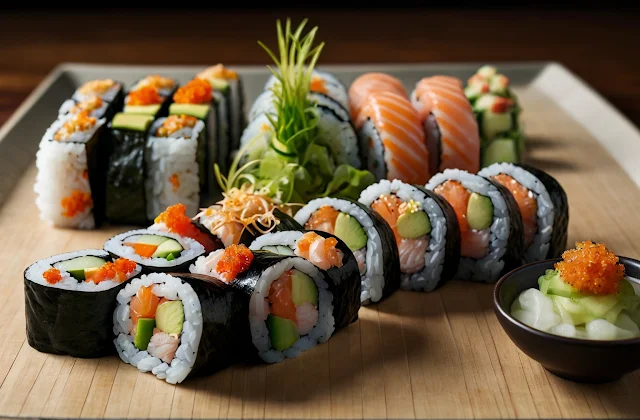Sushi rolls or makizushi, as widely known, is one of the most popular Japanese specialty food that surprises sushi eaters around the globe. These elegant rolls are crafted from sushi rice with vinegar, followed by fresh seafood, assorted veggies and seaweeds. This uniquely shows the mastery of Japanese table presentation. The following essay is going to discover what is so special about sushi rolls, the processes involved in making them, and the place they occupy in the culinary customs of Japanese cuisine.
1. The Allure of Sushi Rolls:
It is the individual differing ingredients made in a sushi roll that have earned them this well deserving reputation from all over the globe for their diversity. Each mouthful of sushi roll provides a concert of flavors and is the result of a beautiful dance of tastes such as the sophisticate umami of the fresh seawater, the lightened-up sweetness of the sushi rice and the little bit salty air of the nori. Not only the vegetables as the crunchiness adds but also the creamy sauces include more complex taste and satisfaction to this grand delicacy.
In addition, sushi rolls are filled with creativity, whether creating new recipes or adapting traditional ones. They can be any way you want. Rolls include the timeless favorites, such as California rolls (crab, avocado, and cucumber), to the daring selections with raw fish, tempura, even fruit. There is a roll for every taste palate. The chance of tailoring the one rolls with different ingredients and the dipping sauces is the factor that adds to intrigue. Moreover, it becomes unique and personal every time we bite into them because we are the only one to make our own in every way.
2. The Intricate Process of Creation:
The making of sushi rolls is about meticulousness, skill, and immersing oneself fully into the process. The preparations involved in the making of sushi rice were the first step into the entire process. This is done by cooking and seasoning with a blend of rice vinegar, sugar, and salt. After that, the rice is placed carefully on a nori sheet leaving a small space at the top and bottom of the sheet.
In next place, a rice portion with fresh vegetables is placed on. These can be the fillet menus of Bengoshi like tuna or salmon or cooked seafood metaborn, like shrimp or eel, and various types of vegetables, like cucumber.avocado, or scallions. The further spicy condiments of something like wasabi as well as soy sauce can be also used to rev up the flavor.
With the materials prepared the sushi roll is wrapped in bamboo mat or wrap used for the purpose. The artisan then cuts the roll into pieces matching the bitesized portion to reveal intricate cross-section of colors and textures. Total work of sushi rolls displayed in the last presentation became an authentic reflection of precision and minute sushi making.
3. Cultural Significance:
Sushi rolls, rolls and sushi, are the meeting place of the most important details of the Japanese cuisine They represent the eating habits and the art of combining sweets with each other, with the utmost care for the flavor and the delicacy of beautiful sweets. Sushi means "sour fish" in Japanese because it was originally a method of preserving fish. However, it has morphed over time into a cherished dish that is appreciated for the possibilities it affords.
Sushi is consumed as a group meal in Japan, where people sit together to eat and talk. The result is their bond. Sushi restaurants whether modern or traditional are simply offering a platform for people to see their handwork implemented in sushi food, including the sushi rolls. More than the sushi, it is its associated culture of intricate detailing, respect for the raw materials and zeal for fine art of cooking that has made Japanese sushi an integral part of Japanese culture as a whole.
Sushi rolls are a musical epic of flavors that manage to use counterpoint in terms of tasting, texturing, and styling to promote harmony. The brief but vibrant bursts of flavor win their hearts. Moreover, rolls are all about the discovery of new tastes when new ingredients are combined. Their visual appeal is also worthy of attention. Not only do we offer them as traditional loyal offers at Japanese restaurants, but they can become a fusion adventure that would remain your memory one of a kind.
Thus, in the next time of savoring a sushi roll, be impressed with beauty of the creation made with many components in it, let the complex tastes of the meal satisfied your tongue and recognize the cultural inpression of it. Sushi rolls denote not only a culinary experience, but also a manifestation of the greatest domestic achievements and a time of cultural celebration for Japan.

